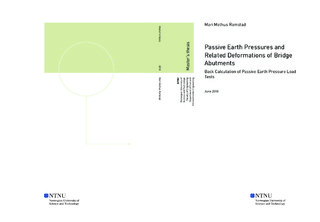| dc.description.abstract | In this thesis the earth pressure theories developed by Rankine, Coulomb, Terzaghi and Janbu have been studied and used for hand calculations. The theories are based upon a series of simplifications and idealizations, and will therefore to a certain degree be inaccurate when compared to experimental results. The biggest limitations of the theories are that they implicitly assume the dilatancy angle psi to be equal to the angle of friction phi, they do not account for the displacement of the wall, in addition to assuming linear horizontal stress distribution with depth. The research suggests that the Janbu theory provides the most accurate results for wall roughness r>0, while all the theories are suitable for calculations where r=0.
This study has consisted of back-calculations of passive loading tests using the Mohr-Coulomb and Hardening Soil Model in Plaxis 2D and Plaxis 3D. Two passive load tests have been back-calculated in order to gather experience on soil behaviour during passive loading. The results suggest that the stiffness parameters E' and E50ref, cohesion cu or c and the friction angle phi are the most important parameters when modeling passive load tests in Plaxis. A critical evaluation of what values of phi to use in Plaxis simulations is recommended. For cases where the backfill is compacted, the use of empirical values in the higher range is recommended. For poorly compacted backfill empirical values in the lower range should be used. The author found that there is good agreement between the experimental load-deflection curves and the curves obtained from Plaxis when adjusting the angle of friction. In Case 1 a narrow wall was modeled, resulting in the 3D simulations being the most accurate. Case 2 consisted of a wide wall where the 2D and 3D simulations displayed similar accuracy. The effect of mesh density was found to be varying for the two cases, with the coarse mesh displaying a failure load overshoot of 7-12% compared to the very fine mesh in 2D, and 7-20% compared to the fine mesh in 3D. The relatively large overshoot in Plaxis 3D is partly due to the poor quality of the 10-node tetrahedral elements. For modeling of wide bridge abutments with plane strain conditions the research suggests that Plaxis 2D should be used, and using a fine mesh will provide accurate results. For narrow abutments Plaxis 3D will be more relevant, and the use of a medium mesh is recommended. When using a medium mesh an overshoot in the range of 5 to 10% is expected. For the reviewed cases the relation between wall height and horizontal displacement at failure was found to be approximately delta_h/H = 3%. | |

